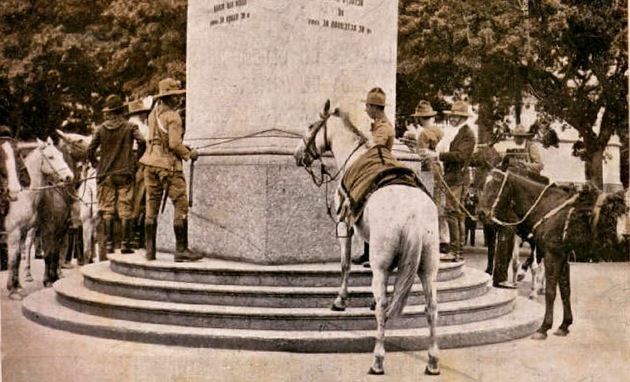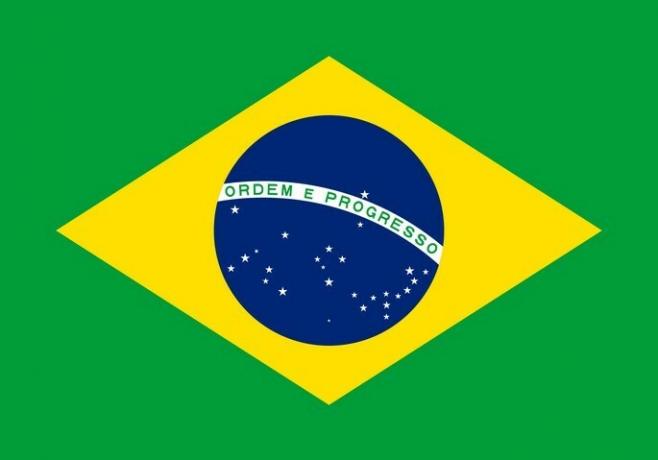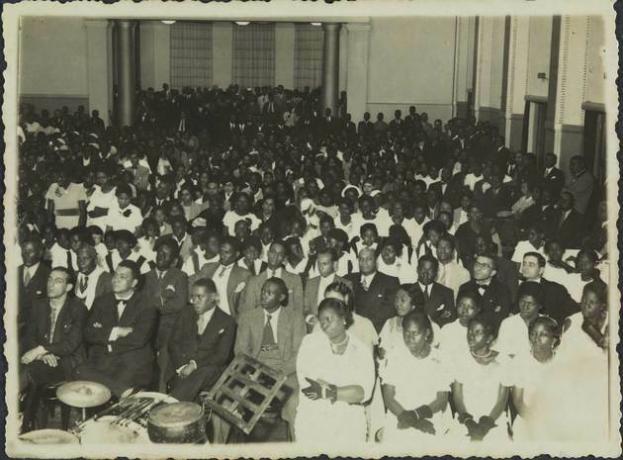Ancient Egypt is a theme much demanded in several entrance exams.
It is also a very important topic in the school curriculum, always present in evidences throughout the school year.
We design and select 11 exercises on the subject, covering politics, religion, geography and economics.
Happy studying and good luck!
Easy level
Question 01
Emperor responsible for the unification of Lower and Upper Egypt, in 3200 BC. Ç.:
a) Amenhotep IV.
b) Menes.
c) Ramses II.
d) Amenhotep III.
e) Tutankhamun.
Answer: b.
Before the unification, carried out by Menes, Upper and Lower Egypt had different rulers. After unification, Ancient Egypt had a pharaoh to command both regions.
Question 02
Ancient Egyptian society was, for the most part, polytheistic, with many gods. Religion for these people was very important. Egyptian society was a society:
a) Absolutist.
b) Theocratic.
c) Democratic.
d) Anarchist.
e) Socialist.
Answer: b.
a) WRONG: The absolutist regime was a form of European government practiced from the Low Middle Ages, centuries ahead of the Ancient Egyptian period.
b) CORRECT. Theocracy is a political system where power is based on religious power.
c) WRONG: Democracy was a political model developed in Ancient Greece, centuries later.
d) WRONG: Anarchism is a political system idealized in the 19th century.
e) WRONG: Socialism is a political system idealized in the 18th century.
Question 03
The Nile River was important to the Egyptians because:
a) Its floods made the land fertile.
b) It was used by the Egyptians for fishing.
c) Guarantee the political unity of Egypt, as it was a way used to interconnect the territories.
d) All of the above alternatives.
Answer: D
The Nile River was extremely important for the development of Ancient Egypt, in several aspects, as the alternatives present.
Question 04
About the pyramids in Ancient Egypt, mark the INCORRECT alternative:
a) The pyramids were built with the aim of being tombs to house the bodies of the pharaohs, who were mummified after their death.
b) The largest pyramid in the world is that of Cheops, 230 meters wide at the base and 174 meters high.
c) The grandeur of the pyramids sought to represent the grandeur of the pharaoh.
d) In construction, both enslaved and free workers had to work.
e) Until today, theories have not been elaborated on how the Egyptians managed to carry and lift such heavy stones for the construction of the pyramids.
Answer: e.
a) CORRECT: The function of the pyramids was to serve as tombs for the pharaohs.
b) CORRECT: There are 123 pyramids cataloged in Egypt, with Cheops being the largest.
c) CORRECT: Building great works as a demonstration of power was and is a common practice of governments throughout history.
d) CORRECT: Slaves and free workers were labor for construction. Peasants performed this service during the floods of the Nile, when they were unable to work in the fields.
e) WRONG: There are several theories about how this work was carried out. Among the most accepted, we have the one that states that the sand was wet in the way that the stones would travel, so that they would slide more easily.
Middle level
Question 05
Regarding work and the different social groups in Ancient Egypt, mark the INCORRECT alternative:
a) Peasants and artisans had the sole function of carrying out work in the fields. During periods of high Nile, they would lock themselves in their homes to pray to the gods for a good harvest in the future.
b) Priests were of great importance in Egyptian political and religious life. They were responsible for rituals and religious festivals.
c) The scribes were state employees whose function was to record the main events of the pharaoh's society and life.
d) Pharaoh was the one who held the greatest power in the Egyptian government. He was seen as a god, his office being passed down hereditary.
ANSWER: a.
a) WRONG: In periods of flooding of the Nile, peasants should carry out work on the construction of the pyramids and artisans should prepare items for the decoration of their interior.
b) CORRECT: The spiritual and earthly life of the Egyptians mixed a lot. Because of this, the priests, individuals responsible for religious rites, had a lot of prestige.
c) CORRECT: Scribes had great prominence in Egyptian society, among other reasons, for their ability to record histories and organize administrative sectors.
d) CORRECT: We call the Egyptian government a theocratic government, given the importance of religion in politics.
Question 06
Regarding art in Ancient Egypt, consider V for true statements and F for false.
( ) Most Egyptian works of art had religiosity as their central theme.
( ) The dimension of the individuals portrayed in the paintings aimed to demonstrate the social hierarchical levels. The smaller the individual, the less prestige and power he has in society.
( ) A striking point in Egyptian paintings was the predominance of three dimensions in the drawings.
( ) According to the Law of Frontality, the change and the eyes of individuals should always be represented from the front. The head, legs and feet are in profile.
( ) The Egyptian sphinxes had the human head and the body of a lion so that the head represented wisdom and the body, strength.
a) V-V-V-F-V.
b) F-V-F-V-V.
c) T-V-F-F-V.
d) V-V-F-V-V.
e) T-F-V-V-V
ANSWER: D.
III - FALSE: The Egyptian paintings were marked by the absence of three dimensions, having only two.
Question 07
Regarding religious practices in Ancient Egypt, mark the correct alternative:
a) As in Christianity, the Egyptians believed in the possibility of life after death. However, only individuals from the lowest social strata could reach it, as they were the only ones seen by the gods as truly deserving.
b) The mummification process, carried out on the bodies of pharaohs, priests and some nobles, had nothing to do with the idea of life after death, but with the belief that the body after death should remain intact so that future generations could meet the main leaders of this civilization.
c) The priests had an important role in Egyptian religiosity, being responsible for maintaining the “cosmic order”.
d) An important feature of the ancient Greek gods was anthropozoomorphism: the idea that the gods would live among the peasants and slaves to watch over the humans and choose those who might find the salvation.
e) None of the above.
ANSWER: C.
a) WRONG: Life after death could be achieved by everyone, regardless of their social position.
b) WRONG: Mummification had a direct relationship with the belief in life after death.
c) CORRECT. The priests had great prestige for the Egyptians.
d) WRONG: Anthropozoomorphism is the characteristic of the Egyptian gods, who were represented with the human head and the body of an animal. Anthrop: man; Zoo: animal; Morphism: shape.
e) WRONG: Option C is correct.
Question 08
Tick V for true sentences and F for false ones.
( ) In Egyptian society, social mobility was practically non-existent.
( ) The scribe was responsible for carrying out tax control and other administrative functions, in addition to recording the important facts of the pharaoh's life.
( ) The Egyptians had a 365-day calendar based on observing the path of the sun.
( ) The pharaoh could not collect taxes on the production of the peasants, as the lands were private, in the possession of the nobles.
a) F-V-V-F.
b) V-V-V-V.
c) V-F-V-V.
d) V-V-V-F.
e) V-F-V-F.
ANSWER: D.
IV - FALSE: All lands in Ancient Egypt were owned by the Pharaoh. Everyone should pay taxes to him.
Hard level
Question 09
(PUC – GO 2019) – Read the synopsis of the movie The Gods of Egypt (2016):
“Humanity's survival is threatened when Set, the merciless god of darkness, seizes the throne of Egypt and turns the thriving Empire into chaos. Hoping to save the world and rescue his true love, a mortal named Bek forms an unlikely alliance with the mighty god Horus. Your battle against Set and his squires spans the beyond and the skies for an epic showdown.”
(Available in: https://g.co/kgs/HquKrA. Accessed on: 15 Jul. 2018. Adapted.)
The script for this film is based on some mythological aspects of ancient Egyptian civilization. The fight of Osiris and Horus against Set stands out, which represented the continuity of the sunrise and, consequently, of life. Knowing that Osiris, the god murdered by Set, is considered the first pharaoh of Egypt and that subsequent pharaohs were representatives of the Sun, mark the correct alternative:
a) The religious unification attempted by Amenhotep IV, around the solar god Aten, indicates an effort to reinforce the pharaonic power, relating, probably for the first time in history, monotheism to the domination of a single leader.
b) The fight between the deities Osiris and Set is a poetic way of narrating the conflict between the pharaohs Tutankhamun and Akhaenaten, who waged a war that left Egypt devastated and allowed the domination of the Hebrews.
c) The pyramids of Giza were temples aimed at carrying out the popular worship of the solar god Aten. The Egyptian people built three of them to represent the three sons of Ramses II, founder of the last Egyptian dynasty, who followed him in the role of pharaohs.
d) The greatest proof of the mixture between religion and politics in ancient Egypt is the imposition of the obligation to mummify the pharaohs, which was faithfully obeyed by the Egyptian people. With this practice, the population recognized that the pharaonic sovereignty had continuity in the world of the dead, reign of Anubis.
ANSWER: a.
During the reign of Amenhotep IV, in order to diminish the power of the priests, the pharaoh instituted the worship of a single god, the Sun. Shortly after his death, polytheism was restored in Ancient Egypt.
question 10
(FACERES – 2018) – Read the following excerpt:
“The image of ancient Egypt that we have in the common sense of the contemporary West is so artificial that a child hardly associates Egypt with its continent, Africa (...). The people of ancient Egypt were black. Several ancient texts (Greek and Arabic) report them in this way. In modern historiography, however, these texts are ignored. The process of building a Eurometric image of the Egyptian people takes place in a machinic way: art, literature and the media westernize their image (whiten the skin and normalize their social relations by the European standard); their existence as a people is dissociated from Africa”.
(COURI, Aline. The historic whitening of Egypt. 11 Apr. 2016. Available in https://www.geledes.org.br Accessed on 25 Feb. 2018).
According to the point of view exposed in the text by researcher Aline Couri, regarding this process of “whitening” of ancient Egypt, it is correct to say that:
a) It is the result of that people's desire to resemble the potentially superior Europeans of the time.
b) It is a process derived from the historical documents that described the Egyptian people of fair, Caucasian complexion.
c) This is a reverse racism, as the Egyptians of today seek to distance themselves from their Europeanized past.
d) It is a historiographical racism, which neglected the blackness of one of the most important African peoples.
e) This is a vision that comes from Arab and Greek children, who do not associate Egypt with their continent, Africa.
ANSWER: D.
The question addresses the way in which the “whitening” of the Egyptians through historiography, art and modern media is related to the so-called historiographical racism.
In this way, the image created about Ancient Egypt sought to bring them closer to Western values and culture and distance them from the characteristics of other peoples who lived geographically close to them, on the continent African.
question 11
(SÃO CAMILO – 2019) – The Egyptians saw the creation of the world as a kind of island of order surrounded by the forces of chaos, which threatened it constant annihilation, just as the fertile and orderly Delta and Vale were surrounded by hostile deserts and anarchic.
(Cyrus F. S. Cardoso. Ancient Egypt, 1982. Adapted.)
The text helps to understand why, in Ancient Egypt, religious practices
a) being disconnected from everyday experience, as it was believed that the deities had little interference in the movements of nature and human destinies.
b) depend on the intermediation of priests, who condemned attitudes of the faithful, such as idleness, the pursuit of wealth or sexual practices not aimed at procreation.
c) be used by the rulers as a way to deceive and deceive the poor population, who came to believe that the pharaohs were representatives of the gods on Earth.
d) penetrate all aspects of public and private life, as in ceremonies to guarantee the arrival of the flood, to give thanks for the harvest or to procreate.
e) restricted to the nobility and priests, since most of the population was illiterate and had no access to mythical texts and religious works.
ANSWER: D.
a) WRONG: religious practices in Ancient Egypt were related to all aspects of the lives of these peoples. The excerpt presents this by demonstrating a clear parallel between the physical aspects of Egyptian geography and mystical issues.
b) WRONG: the characteristics listed were not among the condemnations carried out by the priests.
c) WRONG: it is necessary to understand aspects of Egyptian religiosity beyond a simple game of interests between different social groups.
Understanding nobles and pharaohs as “smart” and peasants and artisans as “fools” reinforces an erroneous and stereotyped view of Egyptian civilization.
d) CORRECT. In Ancient Egypt, spiritual and earthly life intermingled.
e) WRONG: the fact that most of the population is illiterate and does not have access to mystical texts does not exclude them from religious practices.
Read more:
- Ancient Egypt
- Pharaoh
- egyptian art



